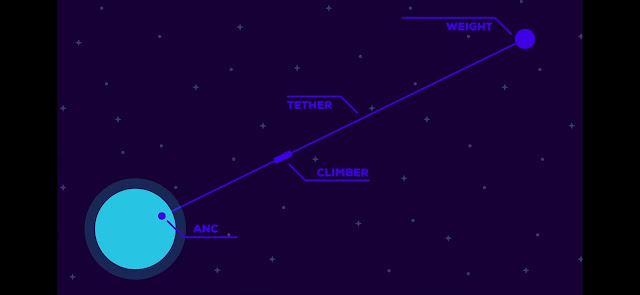Space Elevator
Space Elevator
It's hard to get to space As much as we as a whole wish there were an easy, and affordable approach to see our planet coasting in obscurity Right now, the main route is to turn into an astronaut or a billionare But there is an idea that may make it possible - while serving as the starting point for the exploration of the universe-The space elevator How precisely does it work?
What is Orbit?
To understand how a space elevator will get us into space We must first understand what an orbit is Being in orbit basically means falling towards something, however moving fast enough to miss.
On the off chance that you toss a ball on earth it makes a curve through the air, and afterward hits the ground In space, gravity makes you move similarly, yet on the off chance that you move sideways fast enough the bend of the earth makes the ground fall away underneath you as fast as gravity pulls you towards it.
Be that as it may, the space elevator would without an uncertainty be the single largest and most expensive structure at any point worked by humans So, is it justified, despite all the trouble? Everything comes down to costs Rockets consume an enormous measure of rocket fuel just to get a small measure of cargo into space At current prices, it costs about $20,000 to place one kilogram of payload into space that is $1.3 million dollars for the normal human $40 million dollars for your vehicle billions for a universal space station This immense cost is one of the significant limitations of human spaceflight Even with propelling innovation, this cost isn't probably going to be practically identical with the cost of a carrier ticket at any point in the near future A space elevator would solve this issue.
what would a space elevator look like in real life?
So A space elevator has four significant components: the tether, grapple, counterweight and climber The elevator part of the space elevator is the tether and the climber It extends from the surface of the Earth to space The climber resembles a traditional elevator carriage A chamber that works its way all over the tether At the base would be a stay sticking the tether to the Earth alongside a port for climbers At the top is the counterweight which holds up the tether The tether is held tight like a rope and supported from above by the tension from the counterweight Located higher than 36,000 kilometers over the Earth's surface At the counterweight could be a space station, a starting point for all missions from the spaceport elevator.
But can we actually build one?
It's hard to say The biggest test is the tether It needs to be light, affordable and more stable than any material we can deliver right now There are promising materials like graphene and jewel nanothreads, yet even they may not be strong enough And aside from being unfathomably strong, the tether would also need to withstand atmospheric corrosion, radiation and micrometeorite and debris impacts Additionally, it takes several days to climb the elevator How would we power the climber It requires a great deal of energy to go up Do we need an atomic reactor on our elevator carriage Or do we pillar it power starting from the earliest stage a super controlled laser And where do we get the crude materials for a 36,000-kilometer-long tether Do we make it on Earth and dispatch it into space Or do we make it in space and let it down to the Earth? Could asteroid mining be the answer? Set forth plainly, there are still some major mechanical hurdles to survive
Also, a space elevator is not without risk Should the tether break, it would collapse in spectacular style If it breaks close to the grapple the power applied by the counterweight will cause the whole elevator to rise up ascending into space Should it break close to the counterweight the tether will fall, folding over the world and whipping the end off The resulting debris in orbit could pose serious problems to future spaceflight If we build a space elevator on Earth, we need to do it right the first run through For these reasons some experts have proposed first building a space elevator on the Moon The Moon's gravity is a lot more fragile than the Earth's so a flimsier yet existing material like kevlar could serve as a tether Even with every one of these challenges, the result of having a working space elevator would be immense It may be the first step to genuinely turning into a space-faring development Maybe we will never build a space elevator, however in attempting to do so we may become familiar with a dreadful part And with regards to the exploration of the universe, there can't be such a large number of dreams of a glorious future





Comments